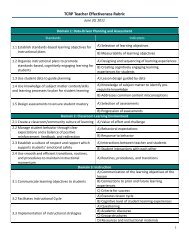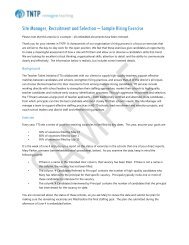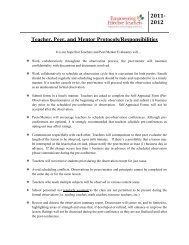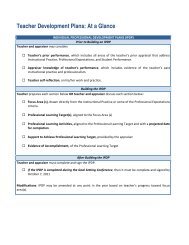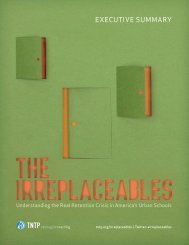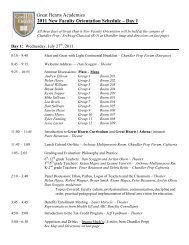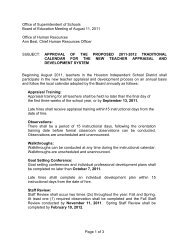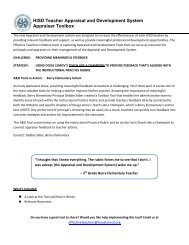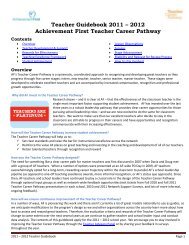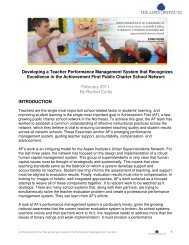TEACHER APPRAISAL AND DEVELOPMENT SYSTEM - TNTP
TEACHER APPRAISAL AND DEVELOPMENT SYSTEM - TNTP
TEACHER APPRAISAL AND DEVELOPMENT SYSTEM - TNTP
Create successful ePaper yourself
Turn your PDF publications into a flip-book with our unique Google optimized e-Paper software.
Houston Independent School District<br />
Teacher Appraisal<br />
and Development System
Overview<br />
HISD is committed to helping each one of its teachers thrive in the classroom—because when our teachers<br />
succeed, our students succeed. First and foremost, that means ensuring that all teachers receive the<br />
individualized feedback and support they need to reach their full potential in the classroom.<br />
This year, the HISD Board of Education took a giant step toward doing just that by approving a new teacher<br />
appraisal instrument and process, as well as an entirely new professional development structure that will<br />
support our teachers in their classrooms. Designed during the 2010–2011 school year with input from<br />
educators and community members across the district, the new appraisal and development system will give<br />
teachers a more complete and accurate picture of their performance and a clear roadmap for taking their<br />
knowledge and skills to the next level.<br />
A system<br />
designed<br />
by Houston,<br />
for<br />
Houston<br />
Under the new system,<br />
all teachers will:<br />
n receive regular, formative feedback throughout the year to help them identify<br />
successful teaching practices and address the specific challenges they are facing<br />
in their unique classrooms,<br />
n work with appraisers to create an individualized development plan that identifies specific areas for<br />
professional growth, and<br />
n have access to learning opportunities customized to help them meet their professional goals.<br />
When it comes to student success, teachers matter most. High–quality professional development delivered at<br />
the campus and classroom level by educators with track records of success, along with an improved teacher<br />
appraisal system, will give teachers the supports they need and deserve.
Appraisal and Development Cycle<br />
The new system is designed to provide teachers regular feedback and individualized support that help them<br />
grow professionally at every stage of their careers.<br />
All teachers will participate in the appraisal process every year. The process is centered on three conferences<br />
between teachers and their appraisers—one Goal–Setting Conference in the fall, one Progress Conference in<br />
the winter, and one End–of–Year Conference in the spring. In these conferences, appraisers and teachers will<br />
discuss all aspects of the teacher’s performance, the teacher’s progress toward his or her professional goals,<br />
and the teacher’s focus areas for the next several months. Appraisers will also share information about the<br />
teacher’s appraisal rating.<br />
“It gives me, as a teacher, more voice… I get to<br />
communicate with [my appraiser] throughout the<br />
year.”<br />
– Charlyn Henderson, HISD teacher<br />
Individualized<br />
Development<br />
Learning activities<br />
informed by<br />
development plan<br />
Self–Reflection<br />
Reflect on<br />
performance,<br />
student progress, and<br />
professional goals<br />
Appraisal<br />
and<br />
Development<br />
Cycle<br />
Conferences<br />
Collaborative meetings<br />
between teacher<br />
and appraiser<br />
Observations<br />
and Feedback<br />
Observations and<br />
walkthroughs followed<br />
by feedback on<br />
teaching practice<br />
Teachers will have tools to reflect regularly on their<br />
practice so that they can drive their professional<br />
learning and growth with their appraiser.<br />
Through the conferences and<br />
post–observation feedback,<br />
teachers have regular opportunities<br />
to engage in dialogue with their<br />
appraiser about their practice and<br />
development. Between conferences,<br />
teachers will receive regular<br />
feedback. Appraisers will:<br />
n Conduct at least two formal<br />
classroom observations and<br />
at least two walkthroughs<br />
throughout the year—each<br />
followed by in–person and/or<br />
written feedback.<br />
n Provide informal feedback based<br />
on additional observations and<br />
reviews of student performance.<br />
n Connect teachers with<br />
individualized development<br />
opportunities designed to<br />
address their individual<br />
focus areas.<br />
Every teacher will have one appraiser who is ultimately responsible for all aspects of the appraisal process,<br />
including providing feedback and access to development opportunities and assigning a summative appraisal<br />
rating. All appraisers will be school-based administrators who are trained and certified on the new system.
Professional Development<br />
and Support<br />
Four key features of the new system will ensure<br />
that teachers have access to development<br />
opportunities that help them do their best work<br />
in the classroom at every stage of their careers:<br />
n Development Plans: All teachers will have<br />
individualized development plans to help<br />
guide their professional growth. Plans will<br />
identify specific areas for professional growth<br />
informed by results of the appraisal process<br />
as well as strategies for meeting these goals.<br />
n individualized Learning and<br />
Development Activities: Teachers will<br />
have access to job–embedded and school–<br />
based learning opportunities customized<br />
to the specific areas of focus in their development plans. These activities could include peer coaching,<br />
workshops, and analysis of student data.<br />
n Self-Reflection: By reflecting on their practice throughout the year, teachers will take ownership of<br />
their professional growth and lead discussions with their appraiser about progress in the classroom.<br />
n Teacher Development Specialists: These content–area experts will provide individualized and<br />
small–group support for teachers on campuses by coaching and mentoring them, giving them feedback,<br />
and connecting them with appropriate resources.<br />
HISD is committed to giving all teachers the support they need to be successful. That means offering learning<br />
opportunities customized to fit each teacher’s individual professional goals.<br />
“I think this is going to not only make<br />
me a better teacher but it’s going to<br />
transform the work on our campuses.”<br />
– Sarah Stafford, HISD teacher
Performance Criteria<br />
No single measure can tell the full story of<br />
a teacher’s performance. The new system<br />
recognizes that every teacher and every<br />
classroom is unique, and it gives teachers<br />
multiple ways to demonstrate their success.<br />
Instructional<br />
Practice<br />
The new system evaluates teachers based<br />
on multiple measures in three major<br />
performance criteria: Instructional Practice,<br />
Professional Expectations, and Student<br />
Performance.<br />
Every teacher will earn a rating on a fourpoint<br />
scale in each of these areas, and<br />
these ratings will be combined into a<br />
single summative appraisal rating of Highly<br />
Effective, Effective, Needs Improvement,<br />
or Ineffective. Student performance will<br />
be considered in combination with a<br />
teacher’s rating in Instructional Practice and<br />
Professional Expectations to determine a<br />
summative appraisal rating.<br />
Student<br />
Performance<br />
Professional<br />
Expectations<br />
“Effective teachers<br />
grow successful<br />
students.”<br />
– Dr. Terry Grier,<br />
Superintendent
Instructional Practice and Professional Expectations<br />
The Instructional Practice criteria reflect the skills and knowledge that help teachers boost student learning.<br />
They describe the standard of effective teaching practices that all HISD teachers should strive to meet.<br />
Instructional Practice Criteria<br />
Planning<br />
PL-1. Develops student<br />
learning goals<br />
PL-2. Collects, tracks,<br />
and uses student<br />
data to drive<br />
instruction<br />
PL-3. Designs effective<br />
lesson plans, units,<br />
and assessments<br />
Instruction<br />
I-1. Facilitates organized, student–centered, objective–driven lessons<br />
I-2. Checks for student understanding and responds to student<br />
misunderstanding<br />
I-3. Differentiates for student needs by employing a variety of<br />
instructional strategies<br />
I-4. Engages students in work that develops higher–level thinking skills<br />
I-5. Maximizes instructional time<br />
I-6. Communicates content and concepts to students<br />
I-7. Promotes high academic expectations for students<br />
I-8. Students actively participating in lesson activities<br />
I-9. Sets and implements discipline management procedures<br />
I-10. Builds a positive, respectful classroom environment<br />
The Professional Expectations criteria reflect a set of objective, measurable standards relating to a teacher’s<br />
professionalism. They describe the professional behaviors expected of every teacher in HISD.<br />
Professional Expectations Criteria<br />
Professionalism<br />
PR-1. Complies with policies and procedures at school<br />
PR-2. Treats colleagues with respect throughout all aspects of work<br />
PR-3. Complies with teacher attendance policies<br />
PR-4. Dresses professionally according to school policy<br />
PR-5. Collaborates with colleagues<br />
PR-6. Implements school rules<br />
PR-7. Communicates with parents throughout the year<br />
PR-8. Seeks feedback in order to improve performance<br />
PR-9. Participates in professional development and applies learning<br />
Appraisers will assess the Instructional Practice and Professional Expectations criteria throughout the year through<br />
various activities such as classroom observations and walkthroughs, ongoing interactions with the teacher, reviews<br />
of planning documents and resources, and reviews of items such as parent communication logs and teacher<br />
attendance records. Additionally, teachers may provide additional information on their performance for their<br />
appraiser to consider.
These specific criteria will guide appraisers for consistency and fairness, and they will give teachers a clear set<br />
of standards that they are expected to meet. Rubrics, designed on a four–point scale, will clearly articulate the<br />
performance levels for each Instructional Practice and Professional Expectations criterion.<br />
Student Performance<br />
Because a teacher’s primary responsibility is to help students learn, measuring student learning is an important<br />
component of the appraisal criteria. The Student Performance criteria reflect each teacher’s individual impact<br />
on student learning. To ensure fairness and appropriateness, the criteria include multiple measures of student<br />
learning that vary based on the grade level or subject taught by the teacher.<br />
Measures will include students’ progress on statewide and districtwide assessments, progress on teacher–<br />
designed end–of–course assessments, as well as student work products and performance tasks. Although<br />
“value–added” scores will generally be part of a teacher’s appraisal when they are available, no teacher’s<br />
Student Performance rating will be based solely on value–added data. All teachers will have at least two<br />
measures of student learning included in this category.<br />
For the full Instructional Practice and Professional Expectations rubrics as well as complete details about the<br />
measures of student learning included in the system, visit www.hisdeffectiveteachers.org.
HISD Values Teachers<br />
Research has shown that teachers matter most when it comes to student learning and achievement.<br />
Therefore, the HISD Board of Education, with input from thousands of Houston stakeholders, has prioritized<br />
placing an effective teacher in every classroom. The goal of this core initiative of the district’s Strategic<br />
Direction is simple: effective teaching in every classroom, in every school, every day. A key strategy of the<br />
Effective Teacher Initiative is implementing a new teacher appraisal and development system, which emphasizes<br />
professional development and individualized support to teachers. HISD is committed to supporting and<br />
developing its teachers. This new system is designed specifically to give all teachers the regular feedback they<br />
deserve as professionals and the individualized support they need to thrive in the classroom—because when<br />
our teachers succeed, our students succeed.<br />
2011 HISD Board of education<br />
Paula M. Harris, President<br />
Manuel Rodríguez Jr., First Vice President<br />
Anna Eastman, Second Vice President<br />
Carol Mims Galloway, Secretary<br />
Michael L. Lunceford, Assistant Secretary<br />
Lawrence Marshall<br />
Greg Meyers<br />
Harvin C. Moore<br />
Juliet K. Stipeche<br />
Terry B. Grier, Ed.D., Superintendent of Schools<br />
Work on the Effective Teachers Initiative is made possible by the generous support of:<br />
Scan with your ‘smart phone’ to visit the HISD Effective Teachers website.<br />
www.hisdeffectiveteachers.org<br />
Houston Independent School District<br />
Hattie Mae White Educational Support Center • 4400 W. 18th Street, Houston, TX 77092





